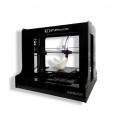Results 1 to 9 of 9
-
05-19-2014, 11:25 AM #1NewMatter Representative

- Join Date
- May 2014
- Posts
- 60
Video of prototype X-Y drive mechansim
New Matter has posted a new video of the very first prototype of the X-Y pinion drive mechanism. It's a good demonstration of the speed, acceleration, and stability of the drive system used in the MOD-t printer. The table is simply held in place by gravity, yet the motion is quite secure, even with fairly high accelerations.
Last edited by NewMatter; 05-19-2014 at 03:08 PM.
-
05-19-2014, 12:15 PM #2Staff Engineer

- Join Date
- Dec 2013
- Location
- Georgia
- Posts
- 934
That's crazy fast, and I definitely like how the rack and pinion system goes together. (it really gives me that "why didn't I think of that" feeling) I wonder how careful you have to be to keep the pinion greased and how it holds up with dust and plastic vapor during operation. Also, how difficult is it to align the platform so you don't have the pinion gear skipping teeth between the two racks?
-
05-19-2014, 02:34 PM #3NewMatter Representative

- Join Date
- May 2014
- Posts
- 60
Lubrication is not really a problem - we're running the acetal racks on steel pinion rods with no lubrication. Printed objects themselves are usually pretty light (rarely over 1/2 lb), so there's not much friction.
Also, aligning the platform is easy - you just align an edge of the platform with the side of the enclosure. The homing routine will detect if the platform is misaligned, and potentially even correct mis-alignemnt by forcing the platform into the correct orientation.
-
05-19-2014, 02:53 PM #4Student

- Join Date
- May 2014
- Posts
- 18
This is great! I wouldn't have ever though of using this technique for moving the build platform. So simple, yet so genius!
-
05-19-2014, 03:18 PM #5Staff Engineer

- Join Date
- Dec 2013
- Location
- Georgia
- Posts
- 934
I agree, Octavio. When I saw the original render, I thought it was using a screw drive and thought it would be slow and complicated, but the rack and pinion system is actually pretty slick.
The racks are made of a plastic to keep friction down then? I understand that the prints aren't terribly heavy, but with it moving at that speed up and down the pinion, you'll likely end up with pretty fast wear on the racks. Though I assume the build platform is pretty easy to replace when those racks do eventually wear down (buying more than one build plate probably isn't a bad idea, to start a new print while prying off/cleaning up after the finished one.) I guess I didn't think of just placing the tray in the corner of the box. What kind of positioning sensor or end stops do you have planned for it? Or does it even need them if it assumes you put the plate in the same "home" corner every time?
-
05-19-2014, 05:45 PM #6NewMatter Representative

- Join Date
- May 2014
- Posts
- 60
Wear does not seem to be a problem so far in our testing. Sure, the build plate will wear out sometime, but you should be able to do a lot of printing before needing to replace the build plate. And, as you say, it is easily replaceable (and being injection molded, should be fairly inexpensive).
Regarding homing sensors, we're working on a novel approach to that. We'll be announcing those details in the Indiegogo launch on 5/28. (Soon!)
-
05-19-2014, 08:20 PM #7
This looks amazing! What a great way of moving the build plate.
-
05-21-2014, 07:27 PM #8
It's very clearly different and ingenious.
But how is it better?
It's fast in the x-y...not a real requirement. Accuracy needed, not speed.
The print plate now sits on a pair of spinning elongated pinion gears instead of being secured by linear bearings. That's not an improvement.
Cheap? Perhaps.
Better? Can't see it.
-
05-21-2014, 11:13 PM #9NewMatter Representative

- Join Date
- May 2014
- Posts
- 60
True. We aren't claiming that the pinion rod X-Y mechanism is better than the drive system on a $1300 printer or even a $600 printer. What it does do, though, is help us to put together a very respectable printer for less than $300. The pinion drive system, in conjunction with other innovations (to be announced with the Indiegogo launch) will give the MOD-t a unique combination of performance, reliability, usability, and affordability.




 Reply With Quote
Reply With Quote









QIDI Slicer "Plater" is...
04-12-2024, 02:21 AM in QiDi 3D Printer Forum